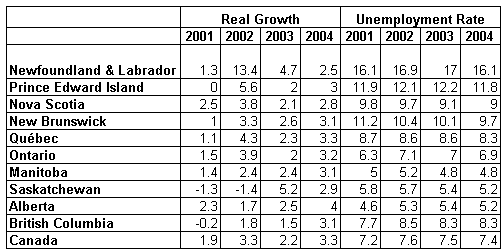News Releases
Economic growth prospects in Canada have been hurt this year by anemic U.S. growth, a strong Canadian dollar, high energy prices and special factors such as SARS and ‘mad cow’ disease, says a BMO Financial Group economic report released today. As a result, the Canadian Regional Outlook report notes most regions of the country will see slower growth rates in 2003 than in 2002.
BMO’s economists anticipate a pick-up in the pace of Canada’s economic expansion during the last half of this year and into 2004 as the U.S. economy stages its expected robust rebound. Economic growth at the national level is forecast to slow to 2.2 per cent this year down from 3.3 per cent in 2002 before accelerating back up to 3.3 per cent in 2004.
“After outperforming the U.S. economy for the past four years, the Canadian economy will grow more slowly than its U.S. counterpart both this year and next,” said Rick Egelton, Deputy Chief Economist, BMO Financial Group. “The main reason for this reversal is the loss of competitiveness associated with the sharp rise in the value of the Canadian dollar.” BMO’s economists expect the Canadian dollar to remain close to its current level over the forecast period.
The nation’s unemployment rate will remain in the range of 7.5 per cent over the forecast period. With the evident softness in the economy, the Bank of Canada is expected to stand pat, leaving interest rates where they are until early 2004, although there is a risk of a rate cut if the economic signals remain weak during the next few months. With stronger growth projected for 2004, BMO’s economists project short-term rates to reach four per cent.
The Canadian Regional Outlook picks Saskatchewan to be the nation’s growth leader this year, reflecting an end to two years of drought conditions. British Columbia’s economy is projected to record the slowest growth this year, but the report notes the province’s resilience in the face of the on-going U.S. lumber duties, government cutbacks, and the impact that the higher dollar and concerns about global insecurity have had on tourism.
The economies of Quebec and Ontario – with large trade-intensive manufacturing sectors – are also absorbing much of the impact of the dollar’s sharp rise and the sluggish U.S. market. In addition, BMO’s economists estimate that SARS has reduced economic growth in Ontario by almost half a percentage point this year.
In the Atlantic provinces, Newfoundland & Labrador stands out for its strong performance this year, buoyed by continued growth in oil output and initial investments in the Voisey’s Bay project.
Nova Scotia will likely record a growth rate near the national average this year – supported by a very hot housing market – following its strong performance in 2002. Last year, output was bolstered by substantial investments in upgrading a drilling platform, tire manufacturing, and fish processing. However, this year, disappointing results from offshore natural gas exploration and weaker conditions in the manufacturing and tourism sectors will restrain the province’s pace of expansion.
Similarly, PEI’s economy has lost some momentum this year following a strong performance in 2002 due to a recovery in the potato crop and food processing. The province is also facing a slowdown in job creation and a headwind in the tourism sector.
New Brunswick should record better-than-Canada growth this year as strong home-building activity offsets weakness in consumer spending and the province’s export markets.
While the Alberta treasury will benefit from stronger-than-expected energy prices, the economy is projected to remain in a relatively slow-growth mode in 2003. The energy sector is experiencing lower production of natural gas and conventional light crude oil, and firms are concentrating on rebuilding their balance sheets. The Alberta economy will also face the largest adverse impact of the ‘mad cow’ (BSE) fallout. Alberta’s growth is projected to re-accelerate in 2004 as stronger energy-related investments finally emerge.
Despite a moderation in job creation, the Manitoba economy is expected to keep pace with growth in the rest of the country. Strong residential and non-residential construction and a rebound in the province’s manufacturing sector are offsetting weakness in household spending.
BMO Financial Group’s regional economic outlook is based on a projection that the U.S. economy will grow by 2.4 per cent this year and 4.1 per cent in 2004. Oil prices are expected to decline from their current levels; West Texas Intermediate is forecast to average US$27.50/barrel this year and US$23/barrel in 2004. Natural gas prices should average US$4.70/mmbtu, up more than US$2 from last year. Other commodity prices – such as those for lumber, newsprint and metals – are likely to trend up from current levels once the pace of global growth picks up.
BMO Financial Group’s Economics Department produces the Canadian Regional Outlook twice a year, in spring and autumn. In the interim, provincial forecast tables are updated to reflect newly emerging conditions. A full copy of the current report can be downloaded from BMO Economics Department’s Internet web site, at www.bmo.com/economic.
Canadian Regional Outlook at-a-Glance
(All numbers are per cent changes, unless otherwise indicated)

-30-
